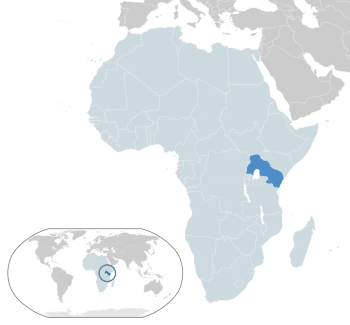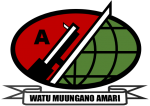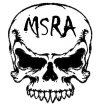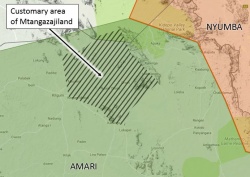Amari
DATE Africa > Amari ←You are here
| Amari | |
|---|---|
 Flag | |
 | |
| Capital | Tehran |
| Largest city | Tehran (12 million) |
| Official languages |
|
| Ethnic groups |
|
| Religion |
|
| Demonym | Arianian |
| Government | Theocracy |
• Supreme Leader | Ayatollah Mahmood Mekhenei |
• President | Ahmad Moudin |
| Legislature | Unicameral Legislature |
| Theocracy | |
| Area | |
• Total | 588,764 sq mi (1,524,890 km2) |
| Population | |
• July 2016 estimate | 8,372,373 (129th) |
• Density | 8,372,373/sq mi (3,232,591.3/km2) (167th) |
| GDP | 2016 estimate |
• Total | $85.77 billion |
| Time zone | WAT |
| |
Amari, with its capital at Kisumu, is a functioning and relatively stable democracy, receiving significant support from the US and other western countries. A new constitution, implemented seven years ago, has attempted to create a framework for better governance with good results. Ethnic and tribal tensions play out in multi-party politics, which has led to a history of electoral violence and distrust of the government. The last election, was uniquely free of the violence of past elections. Other concerns include border security, instability spillover from neighboring countries, regional competition for resources, and terrorism.
Contents
Political
At the heart of political power in Ariana is the Council of Guardians Revolution. The Revolution considers itself the vanguard of proper Islamic sentiment on the planet, and the heart of a global conversion to its version of Islam. The Revolution has successfully defended itself from both internal and external threats, and remains committed to the export of its vision of theocratic rule.
Military
The Amari National Defense Force (ANDF) is the state military of Amari. Its composition, disposition, and doctrine are the result of years of relative peace, but near constant internal security concerns and regional threats. Internal security and the constant struggle against border incursion continue to shape its structure and roles. The ANDF consists of the Amari Army, Air Force, and Navy. Amari paramilitary forces, include the Border Guard Corps (BGC) and Special Reserve Force (SRF). The ANDF is a well-integrated and professional force with good command and control and high readiness. It has a limited force projection capability and a mix of static and mobile forces. Amari is an active contributor to both regional and international peacekeeping forces and has hosted such forces within its borders.
See also Significant Threat Actors within Amari
Economic
The Caucasus countries that possess hydrocarbon resources will continue to depend on the oil and gas industries to drive their economies, while those that do not possess such resources will attempt to tie themselves to hydrocarbon-rich nations. Both Ariana and Atropia face geopolitical difficulties in exporting their oil and natural gas. Bordered by adversaries, the Arianians and Atropians must rely on tenuous routes to export their resources. For Gorgas and Limaria, which lack extractive or mature industries, transshipment of hydrocarbon products or providing other services to oil-wealthy countries will be their primary short- to medium-term means to achieve economic development. Donovia continues to recover from a collapse two decades ago that crippled its economy. All nations of the Caucasus have relatively high inefficiency due to corruption, government involvement in the economy, and/or lack of export industry development.
Ariana’s economy has pockets of economic vitality but suffers from governmental legislation and regulation that restrict its growth. Ariana’s Gross Domestic Product (GDP) consistently improves about 4-6% annually and even reached 7-8% growth in 2007. Much of Ariana’s GDP growth, however, depends on hydrocarbon revenues that make up the largest sector of the Arianian economy and suffer the whims of international market commodity prices. The Arianian government continues to push for greater market liberalization and reform, but large Arianian special interests are expected to continue blocking economic progressive legislation to prevent any decrease in their power. Additionally, the government plays a significant role in the Arianian economy; its social welfare policies fund various charities and numerous subsidies for commodities ranging from foodstuffs to gasoline.
Ariana’s economy is a series of contrasts. While a population surge reached the labor market over the last decade, Arianian unemployment continued to decrease over the same period. While trade and finance sanctions create significant foreign investment obstacles, overseas trade—especially with East Asian countries—continues to grow as Asia desires raw hydrocarbon resources and Ariana seeks finished consumer goods. Although Ariana’s industrial sector continues as one of the region’s strongest, its factories suffer from international sanctions on the parts and technology needed to update its hardware and techniques.
President Ahmad Moudin’s financial policies support his populist agenda, including an expansionary fiscal policy. Moudin continues to support massive subsidies for the populace; energy subsidies alone account for approximately 12% of Ariana’s GDP. The People’s Wealth Fund (PWF), which uses oil revenue proceeds as a hedge against the volatile price fluctuations on the international petroleum market, supports oil subsidies to the Arianian people. The high oil prices of the last decade filled the PWF coffers with enough revenue to pursue Moudin’s populist policies, like fuel subsidies, and possibly provided funds to continue Ariana’s investment in nuclear technology.
As a result of Ariana’s successful nuclear weapons program, the US Treasury enacted sanctions against Ariana that hamper its international and domestic economic systems and promote policy changes. In addition, the US hopes the sanctions will deter Ariana from providing financial support to Middle East terrorists.
Social
Ariana enjoys an ancient heritage and rich culture. Ariana possesses a well-documented reputation as the center of knowledge, art, poetry, and mathematics in the region that dates back thousands of years. Most Arianians are proud of their nation and consider themselves Arianians and/or Persians, dependent on their ethnic group.
Over the last few years, radical Arianian powerbrokers with extremist world views have provided sanctuary to international terrorists. Ariana also sponsored the proxy wars of the Shia Internationalist Brigades and the Martyr’s Army versus Israel, as well as training and/or supplying Arianian Shia insurgent groups such as local Shia Internationalist Brigades. Ariana continues to threaten Israel, the US, and their allies with its domestically popular and successful nuclear weapons program.
Since President Ahmad Moudin took power in 2003, his continual references to the 12th Imam’s imminent return and the establishment of an Islamic Caliphate stir the Shia faithful to action. The rhetoric also diverts increasing social discontent to a common foreign enemy—the US and its infidel allies, such as Israel and Egypt. As long as religious zealots control the government, it remains likely that Ariana and the US will never become allies in the Caucasus region.
Social discontent and civil unrest continue to rise in Ariana. Tens of thousands of people protested the last election (August 2009), in which Moudin received the most votes in what many observers perceived as a rigged election. The perception by many Arianian citizens of deeply ingrained government corruption, skewed wealth distribution, high inflation, and high unemployment rates continue to drive this discontent and unrest. Protests, to include student organized protests, persist even to date in Tehran.
Regardless of these problems, the Arianian populace still enjoys a higher living standard than many regional neighbors. Ariana is not a poor nation. The Arianian poor generally earn more than $2 per day, the United Nations (UN) poverty standard. The government, however, states that only 18% of its citizens live below the poverty line. The Arianian people’s discontent may eventually lead to minor governmental changes but likely will not result in any fundamental changes to the Arianian political situation.
Most citizens enjoy clean water and electricity, most attend primary and secondary schools, and most urban citizens have access to phone services. Literacy rates remain very high in Ariana (77%), and over 80% complete high school. Each year, over one million high school graduates apply for entrance into Arianian universities. The more educated the Arianian public becomes, however, the more likely that they will speak out against the theocracy.
Information
Amari has one of the fastest growing technology sectors on the African continent. Amari's government attempts to manage the various information mediums to maintain a positive perception by the public and other countries in the region. The quick adoption of mobile phone technology and the increased access to the Internet is challenging the governments ability to control public perceptions. Amari’s INFOWAR capability is generally good, with pockets of excellence in a variety of disciplines.
Infrastructure
Amari has over twice the population of Texas but less than five percent of its electrical power generating capacity. Despite that, Amari is still the regional leader in the depth and quality of its infrastructure, key features being the port of Mombasa and the "Northern Transport Corridor" connecting Mombasa to Nairobi and points west. The corridor also serves the resource-rich Lake Victoria region, with a spur to Kisumu as well as a direct line to Kampala. Nairobi is also the region’s major air hub for international trade and tourism.
While Amari wishes to maintain its advantage over Kujenga’s port of Dar Es Salaam and the Dar Es Salaam-Kigoma (DARGOMA) Corridor. It also understands the importance of streamlined border and customs control to regional security and economic development.
Despite abundant petroleum, geothermal, and hydroelectric resources, most of the region’s population depends on wood or charcoal for cooking, and oil lamps for lighting, especially in rural areas. Even those living in cities serviced by electric or water distribution grids are not necessarily connected to those systems.
Physical Environment
Over 200,000 square miles comprise the Caucasus, a mountainous region located between the Black Sea and Caspian Sea. The Caucasus includes Atropia, Limaria, and Gorgas, as well as parts of Ariana, Donovia, and Kalaria. The Caucasus Mountains, consisting of the Greater and Lesser Caucasus ranges, traditionally form the separation between Europe and Asia. The Caucasus region contains two major parts—the North Caucasus and the South Caucasus—that are divided by the Greater Caucasus Mountains. The North Caucasus region is contained entirely within Donovia, while the South Caucasus contains Gorgas, Limaria, Atropia, and parts of Ariana and Kalaria.
Time
The Caucasus countries, for the most part, do not believe in the sensitivity of time, and do not view punctuality or the importance of time as the US and most other Western countries do. Most of the people in the region do not view time as a resource and do not feel any compulsion to effectively manage their time. The people in the Caucasus region do not make the connection between effective use of their time and production. This lack of time consciousness will likely frustrate US soldiers as they work with their allies, but it will also give the US a battlefield advantage against its enemies.
Significant Threat Actors within Amari
Amarian People’s Union (APU)
The Amarian People’s Union (APU) is the militant wing of the Amarian People’s Party (APP). The APU has openly espoused violent actions when political desired are unfulfilled. The APU’s members are predominantly hostile and would likely support enemies of Amari. The APU is responsible for numerous attacks against government facilities and military or police forces. They have also targeted Amari civilians whom they identify as “non-loyal.” The most common attacks include government posts or personnel, machines and power facilities, and civilian crops.
Pemba Island Native Army (PINA)
The Pemba Island Native Army (PINA) is a low-level nativist insurgency, fighting for increased autonomy and relief from alleged Amarian oppression. Low-level violence and vandalism has been directed against Amari officials and BGC units tasked with providing security on the island. While PINA is largely bluster, radical elements break out and have attacked state forces and anyone they deem an “outsider.” The most violent acts usually follow pressing of Amari policies and BGC patrols.
Mara-Suswa Rebel Army (MSRA)
The Mara-Suswa Rebel Army (MSRA) is an aggregate of multiple rebel groups and militias in central Amari, west of Nairobi. The group is allegedly responsible for widespread violence and harassment throughout the region. They have also conducted attacks against tourists and villages in Kujenga and Ziwa. This group is known for brutality and has taken responsibility for attacks on tourists and traffic along secondary roads. Territorial fighting between rival factions has made travel in remote rural areas almost impossible - particularly at night, where sustained gunfire is a nightly occurrence.
Islamic Front in the Heart Africa (AFITHA)
AFITHA is an Islamist militant organization which aims to overthrow the Algerian government and institute an Islamic state. To that end, it is currently engaged in an anti-government campaign. As an affiliate of Al Qaeda in the Islamic Magreb (AQIM), it aligns its movement with AQIM’s broader goals to institute shariah (Islamic law) in all its areas of operation, although its operations in the region have been more practical than its northern component. Its operations in Amari, Ziwa, and northern Kujenga appear to be more focused on ridding the region of "Western impurities" than solely religious ideology.
"Mtangazajiland"
The upper northwestern area of Amari, nicknamed "Mtangazajiland”" – land of the wanderers, is a de facto homeland for former child soldiers. Many of the villages were developed by Amari government programs, while some developed organically as populations swelled. The people in the villages are mostly single men between 16 and 40 years old that escaped forced service with militias and other forces in Nyumba, although some have started families.There are approximately 15-20 villages in the area, with a few in decline and a few splinters from other villages. The Amari Interior Ministry provides partial support to many of the villages to help rehabilitate the men and prevent potential conflict from migrating elsewhere. Villagers are predominantly friendly towards Amari officials, but are suspicious of outsiders.
Cross-border militia raids from Nyumba against the villages occur with some frequency and can be extremely brutal. The level of villager participation in illicit trafficking, interdiction of commercial traffic, or raids on other villages or refugee settlements to supplement state stipends is not known.
Amari military forces regularly allocate resources and provide assistance and monitoring of the villages to ensure their ongoing stability and rehabilitation. These former child soldiers likely maintain numerous small arms. The amounts and types or larger weapons and organization levels is unknown. The villages may present a buffering effect in the northwest, allowing the military and BGC to be more effective in this somewhat wild region.
Hodari Cartel
The Hodari Cartel is the largest and most powerful heroin trafficking organization in the region. Its primary operating base is in and around the Port of Mombasa, although it operates processing and distribution nodes throughout Amari. Limited, tense cooperation among other regional drug trafficking organizations may exist to minimize public or political backlash.
| DATE Africa Quick Links . | |
|---|---|
| Amari | Political • Military • Economic • Social • Information • Infrastructure • Physical Environment • Time |
| Kujenga | Political • Military • Economic • Social • Information • Infrastructure • Physical Environment • Time |
| Nyumba | Political • Military • Economic • Social • Information • Infrastructure • Physical Environment • Time |
| Ziwa | Political • Military • Economic • Social • Information • Infrastructure • Physical Environment • Time |
| Other | Non-State Threat Actors and Conditions • Criminal Activity • DATE Map References • Using The DATE |





